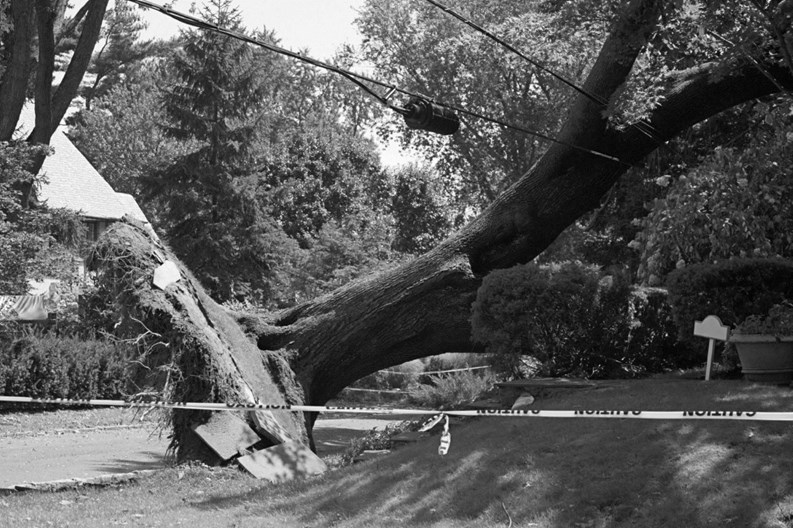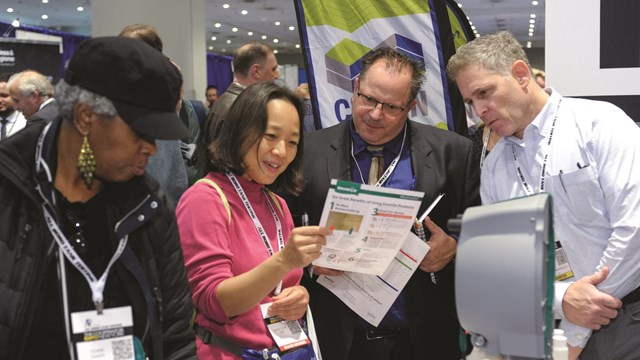The poet Joyce Kilmer wrote, “I think that I shall never see/A poem lovely as a tree,” and many people share that sentiment. Trees bear fruit, offer shade under their leafy branches and provide a convenient tethering point for hammocks. They provide homes for wildlife and beautify our landscapes. There’s also the little matter of producing the air we breathe and regulating the planet’s climate.
As mighty and powerful as trees seem however, they require a great deal of thought, maintenance and care. Trees have to be planted in the right location in order to thrive without causing damage. They may also need to be pruned, and sick trees must be tended to—sometimes removed altogether.
All this work is not just for the sake of aesthetics. Unruly branches can block views, roots can damage sidewalks, and sick trees can fall, causing property damage and personal injury. And then there’s the bottom line—trees can influence home values.
“Your [association’s] image and how you project yourself to the public has an impact on the perceived value of your property,” says Denny Wiggers, owner of Denny Wiggers Landscaping & Gardens in Paramus.
Get Smart About Trees
The key to getting the maximum value out of your association’s trees is to stay on top of them (so to speak) to make sure they stay healthy.
When it comes to tree maintenance, “It should be kind of like going to the dentist,” says Wiggers. “You’re better off bringing in an arborist or another knowledgeable person every couple of years. It may not even cost you any money to call somebody in and walk around with them to get their opinion.”
Smart tree sense starts right at the beginning, when a property is designed, says Paul Carbone, New Jersey and Pennsylvania district sales manager for SavATree and SavaLawn. According to Carbone, many landscape architects may be brilliant when it comes to design, but they may not always consider the type of trees they’re planting on a particular property.
“They never look at what the tree is going to look like three, five, or seven years down the line,” he says. “So it looks great in the immediate moment, and the design looks phenomenal, but then after a few years, it’s no longer functional. It becomes a maintenance nightmare because they put in a plant that’s too wide or too tall and now it’s obstructing views.”
Carbone recommends having an arborist look over your landscape architect’s proposed design to review its plant material before implementing the plan. It’s a service he’s provided for many clients.
“I’ll look at the plant material and then I’ll let you know exactly what it’s going to cost you maintenance-wise as far as disease and insects are concerned,” he says. “And I’ll take a look to see if it’s going to obstruct views to the river or a pool or whatever you’re trying to accomplish.”
Arborists can, for example, recognize if a tree that requires shade is located in a too-sunny area, or vice versa. Or they might see a tree that doesn’t like acidic soil planted near a pine tree, where acidity is high.
“By bringing an arborist out, you can identify these challenges and make the corrections,” says Carbone. “Sometimes you’re lucky enough to be directed to simply move a plant from one section of the property to another, instead of having to get rid of it altogether.”
A Measure of Maintenance
Carbone says the path to smart tree service starts with finding a reputable tree-care company and working out a budget with them. Lots of associations are reluctant to do this, but if you trust the company, the results can speak for themselves.
“What I do is I take a look at what the client’s needs and expectations are, and I design a plan around what they expect from me,” he says. Carbone adds that the keys are determining a budget, finding a quality company, then having an arborist from the company meet with the board or manager to determine the association’s goals.
“Once we have those three things in place, then we can guide you in a direction,” Carbone says. “Sometimes, unfortunately, we tell you things you don’t want to hear like, ‘Unfortunately, Mrs. Smith you spent all this money on plant material that doesn’t belong here.’ So don’t kill the messenger.”
Can Less Be More?
Wiggers says the best way to keep trees on your property healthy may be to actually reduce the total number of trees on it. He says he often comes across properties with a lot of trees, battling each other—and things like telephone poles—to grow. So rather than having 20 trees fighting it out, he recommends having five strong healthy ones.
“I think that a lot of times there are too many trees on these properties,” he says. “I consider myself an environmentalist, so I’m not advocating decimating the environment; I see sometimes [reducing trees] as improving the environment, if it’s a matter of removing weaker trees and letting the healthy ones get stronger.”
By doing that, Wiggers continues, you allow the strong trees to root more strongly and have more robust branches. Low-lying plants and ground animals also tend to thrive more when the tree population is controlled and healthy.
It’s common for property owners and residents to want to save every tree they can—there’s an instinct to see them almost as something sacred. But in natural environments, weaker trees get lost to fires and to stronger trees.
“I try to educate my customers and make them aware that you really have some nice, healthy trees but they’re going to be weakened by the weaker trees because they’re all fighting for life,” Wiggers says.
The Tree Doctor is In
Care and prevention can usually keep trees healthy, but in the event that you do see signs of damage or disease, it’s important to call in an expert right away.
How a professional tree doctor assesses your case depends on a number of factors. Tchukki Andersen, an arborist with the Tree Care Industry Association in Manchester, New Hampshire, compares the process to a person feeling sick and going to the doctor.
Your physician can ask about your eating and drinking habits, your profession, whether or not you exercise and other questions about your lifestyle. Tree experts obviously can’t ask their patients questions, but they can inspect them for signs and possible causes of trouble. They’ll consider the tree species, where it’s located and signs of insect damage. Then they’ll determine if treatment is possible and what that treatment should be. There is a wide range of tree diseases, diagnosis and possible treatments.
“Sometimes you can just show up at a site and you can just look at it and say, ‘This tree is dead because it got hit by lightning—and I know that because it’s still on fire,’” Andersen says. “Sometimes it’s that obvious. Most times though, it takes a lot more detective work.”
For example, half of a tree may be dead, but the other half might be alive. The tree professional will ask how long the tree has been that way, and work inward from there.
“You ask a lot of snoopy questions, you do some probing around the tree, you might inspect the bark, climb the tree, inspect up in the canopy in the upper branches,” Andersen says. “You might also inspect the root zone where the roots enter the ground.”
So let’s say you have a dying tree on your property. What’s the danger in not doing anything about it? It’s only a tree, right? Actually, there can be big ramifications to not reacting to a sick tree. Andersen says it’s likely that a tree with a problem is an older, and therefore bigger, tree—and that can become a safety issue.
“A young tree will usually tend to grow really fast and really strong, even if it has a problem,” Andersen says. “It will appear for the first few years, that, ‘Hey, this tree is doing great’ when actually it is just growing fast enough to overcome whatever problem it may have.”
She cites the example of a 60-foot-tall apple tree that’s big, beautiful and provides terrific shade. It’s not looking healthy, but you decide to just let nature take its course.
“Well, you have a 60-foot tree in your yard that probably has fairly sizable branches,” she says. “When trees start to slow down or get old or get sick, they kind of do what humans do and fall apart, literally. The trees will tend to drop branches, or they can blow over in a slight breeze or no breeze—they just fall over because they don’t have any root zones.”
Those falling branches could fall on a building, damaging roofs or windows, or even worse, strike a person. If a property has a wooded area where there aren’t apartments or storage areas or playgrounds, places where people don’t go, there’s less danger in letting nature take its course (though it’s always possible someone could be out there taking a walk or exploring).
Pruning: Pros & Cons
If a tree is on a residential property, then it’s certainly “interacting” with humans. That means its branches may grow into buildings or block views or, if the branches are low enough, get in people’s way while they’re walking. So you may want to prune a tree, but keep in mind that once a tree is pruned, it’s always going to require pruning—for the rest of its life.
“Every time you prune a tree you need a reason why you’re pruning the tree,” Andersen says. “Depending on the age and size of the tree, you would probably prune it when it is small to give it certain structure so that it doesn’t get super huge and super big all the time.”
But if you prune a tree when it’s small, it’s going to grow back bigger. Andersen compares it to letting your hair grow wild. The difference is, bad hair isn’t fatal. Trees can die if they’re pruned, then ignored because they’ll grow back fast and “clumpy” and branches will fall off, causing damage to the tree.
“And it’s not a big deal,” Andersen says of pruning. “It’s like maintaining your car. Every three years you go in and take it in for a tune-up. It’s a minor inconvenience, it’s money out of your pocket but it helps guarantee that your car stays on the road for a few more miles before it falls apart.”
Safety First
If you aren’t convinced yet that hiring a reputable tree company is of the utmost importance, consider the safety factor. Andersen says there are a lot of people out there working on trees who don’t really know what they’re doing.
“They’ll put a bucket truck too close to the power lines and they get zapped,” she says. “Or they don’t have any training for their employees and they’ll put a tree climber up in a tree that hasn’t been inspected and then the branch falls over or something like that.”
“It’s been a little too common lately,” she continues. “This past year we’ve had way too many accidents in the industry. We’re very much taking a safety-first proactive stance and then of course immediately following that is the care and health of the trees.”
Trees provide beauty, shade on a summer day and a place for kids to play, but taking care of them is serious business.
Anthony Stoeckert is a freelance writer and a frequent contributor toThe New Jersey Cooperator.





Leave a Comment